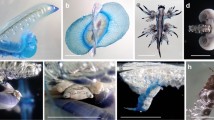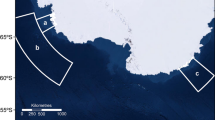Abstract
The abundance and vertical distribution pattern of a halocyprid ostracod,Conchoecia pseudodiscophora, were investigated in the Japan Sea in 1985, 1987 and 1989. Vertical sampling from 500 m depth to the surface in the water around Yamato Rise revealed that this ostracod was second in dominance by number and third to fourth by biomass of the total zooplankton collected with a 0.35 mm mesh Norpac net. Horizontal net tows in Toyama Bay indicated that the major population ofC. pseudodiscophora was distributed below 250 to 300 m depth. No diel migration pattern was evident. Its contribution to total zooplankton there was 5 to 10% or more in terms of biomass. A total of five subadult instars (II to VI) and adult males and females were identified from instar analysis based on sizes and morphological characteristics of specimens collected with 0.10 mm mesh Norpac nets. Data on body length, wet weight and dry weight of each instar are presented. Carbon content of 35 to 48% of dry weight, and nitrogen content of 5.3 to 7.3% of dry weight, were recorded on fresh, freeze-dried specimens of selected instars (subadult Instars IV to VI, adult females). Water and ash contents of mixed specimens of these four instars were 76% of wet weight and 25% of dry weight, respectively. Feasibility of laboratory maintenance ofC. pseudodiscophora was tested, and it produced characteristic “J” shaped faecal pellets. Oxygen consumption rates of subadult instars V and VI, and adult female ranged 0.011 to 0.021µl O2 ind.−1 h−1 at 1 °C, or 2.9 to 6.1µl O2 (mg body N)−0.85 h−1 in terms of Adjusted Metabolic Rate (AMRo 2). There was no appreciable metabolic reduction inC. pseudodiscophora compared to other ostracods, despite their mesopelagic life mode. Subdominance in total zooplankton and nonreduced metabolic activity ofC. pseudodiscophora suggest that this species may be an important link in mesopelagic energy-flow and matter cycling in the Japan Sea.
Similar content being viewed by others
Literature cited
Angel, M. V. (1970). Observations on the behavior ofConchoecia spinirostris. J. mar. biol. Ass. U.K. 50: 731–736
Angel, M. V. (1972). Planktonic oceanic ostracods — historical, present and future. Proc. R. Soc. Edinb. (Sect. B) 23: 213–228
Angel, M. V. (1977). Some speculation on the significance of carapace length in planktonic halocyprid ostracods. In: Loffer, H., Danielopol, D. (eds.) Aspects of ecology and zoogeography of recent and fossil Ostracoda. Junk, The Hague, p. 45–53
Angel, M. V. (1983). A review of the progress of research on halocyprid and other oceanic planktonic ostracods 1972–1982. In: Maddocks, R. F. (ed.) Applications of Ostracoda. Univ. Houston Geosciences, Houston, p. 529–548
Båmstedt, U. (1979). Seasonal variation in the respiratory rate and ETS activity of deep-water zooplankton from the Swedish west coast. In: Naylor, E., Hartnoll, R.G. (eds.) Cyclic phenomena in marine plants and animals. Pergamon Press, Oxford, p. 267–274
Childress, J. J. (1975). The respiratory rates of midwater crustaceans as function of depth of occurrence and relation to the oxygen minimum layer off Southern California. Comp. Biochem. Physiol. 50A: 787–799
Childress, J. J., Nygaard, M. (1974). Chemical composition and buoyancy of midwater crustaceans as function of depth of occurrence off Southern California. Mar. Biol. 27: 225–238
Cohen, A. C. (1982). Ostracoda. In: Parker, S. P. (ed.) Synopsis and classification of living organisms, 2. McGraw-Hill, New York, p. 181–202
Deevey, G. B. (1968). Pelagic ostracods of the Sargasso Sea off Bermuda: description of species and seasonal and vertical distribution. Peabody Mus. Nat. Hist., Yale Univ. Bull. 26: 1–125
Hillman, N. S. (1969). Ontogenic studies of antarctic pelagic Ostracoda. Antarctic J. U.S. 4: 189–190
Ikeda, T. (1974). Nutritional ecology of marine zooplankton. Mem. Fac. Fish. Hokkaido Univ. 22: 1–97
Ikeda, T. (1985). Metabolic rates of epipelagic marine zooplankton as a function of body mass and temperature. Mar. Biol. 85: 1–11
Ikeda, T. (1988). Metabolism and chemical composition of crustaceans from the Antarctic mesopelagic zone. Deep-Sea Res. 35: 1991–2002
Ikeda, T. (1989). Are antarctic zooplankton metabolically more cold-adapted than arctic zooplankton? An intra-generic comparison of oxygen consumption rates. J. Plankton Res. 11: 619–624
Ivleva, I. V. (1980). The dependence of crustacean respiration rate on body mass and habitat temperature. Int. Revue ges. Hydrobiol. 65: 1–47
Kawamura, A. (1989). Fast sinking mouth ring for closing Norpac net. Nippon Suisan Gakk. 55: 1121
Kesling, R. V. (1953). A slide rule for the determination of instars in ostracod species. Contr. Mus. Paleont. Univ. Mich. 11: 97–109
Lochhead, J. H. (1968). The feeding and swimming ofConchoecia (Crustacea, Ostracoda). Biol. Bull. mar. biol. Lab., Woods Hole 134: 456–464
Moguilevsky, A., Gooday, A. J. (1977). Some observations on the vertical distribution and stomach contents ofGigantocypris muelleri Skogsberg 1920 (Ostracoda, Myodocopina). In: Loffler, H., Danielopol, D. (eds.) Aspects of ecology and zoogeography of recent and fossil Ostracoda. Junk, The Hague, p. 263–270
Motoda, S. (1957). North Pacific standard plankton net. Inf. Bull. Planktol. Japan 4: 13–15
Motoda, S. (1971). Devices of simple plankton apparatus V. Bull. Fac. Fish. Hokkaido Univ. 22: 101–106
Müller, G. W. (1906). Ostracoda. Wissensch. Ergeb. d. Deutschen Tiefsee-Expedition auf dem Dampfer “Valdivia” 1898–1899 8: 1–154
Nakamura, C. (1954). Ecological studies onCypridina hilgendorfii G. W. Müller (Crustacea, Ostracoda). In: Nippon suisan gakkai (ed.) Suisangaku no gaikan. Maruzen, Tokyo, p. 108–127 (in Japanese)
Omori, M., Ikeda, T. (1984). Methods in marine zooplankton ecology. John Wiley & Sons, New York
Poulsen, E. M. (1965). Ostracoda-Myodocopa Part I Cypridiniformes-Rutidermatidae, Sarsiellidae and Asteropidae. Dana Rep. 65: 1–484
Poulsen, E. M. (1973). Ostracoda-Myodocopa. Part IIIB. Halocypriforms-Halocypridae Conchoecinae. Dana Rep. 84: 1–224
Rakusa-Suszczewski, S. (1980). Hypostenothermic organisms. Pol. polar Res. (Warsaw) 1: 231–241
Rudjakov, J. A. (1962). Ostracoda Myodocopa of the family Halocypridae from the northwestern Pacific. Trud-Inst. Okeanol. 58: 172–201 (in Russian)
Vannucci, M. (1968). Loss of organisms through the meshes. In: Tranter, D. J. (ed.) Zooplankton sampling. The Unesco Press, Paris, p. 77–86
Vinogradov, M. E. (1968). Vertical distribution of the oceanic zooplankton. Israel Program for Scientific Translations, Jerusalem
Vinogradov, M. E., Sazhin, A. F. (1978). Vertical distribution of the major groups of zooplankton in the northern part of the Sea of Japan. Oceanology, Wash. 18: 205–209
Author information
Authors and Affiliations
Additional information
Communicated by M. Anraku, Tokyo
Rights and permissions
About this article
Cite this article
Ikeda, T. Ecological and biological features of a mesopelagic ostracod,Conchoecia pseudodiscophora, in the Japan Sea. Mar. Biol. 107, 453–461 (1990). https://doi.org/10.1007/BF01313429
Accepted:
Issue Date:
DOI: https://doi.org/10.1007/BF01313429




